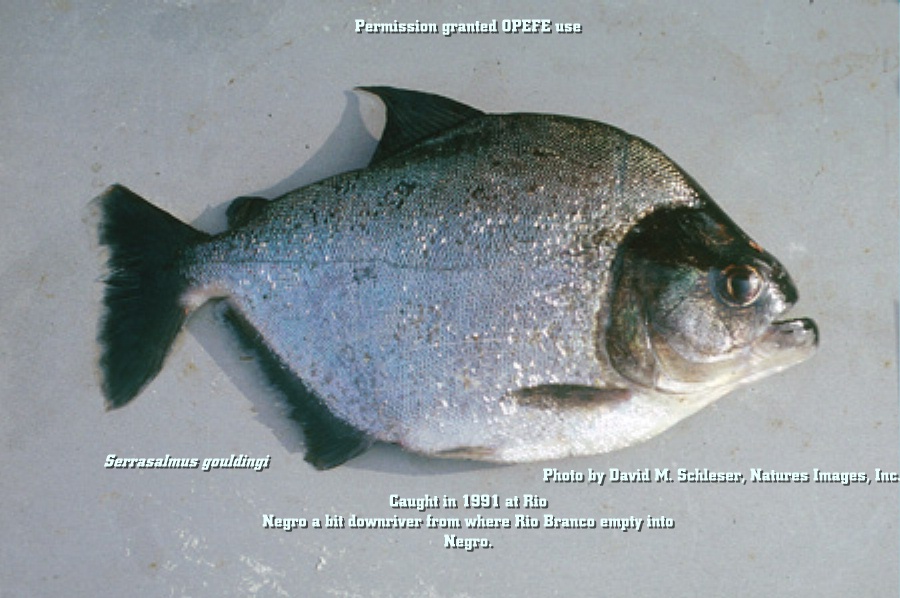 WELCOME TO OPEFE ARCHIVES
WELCOME TO OPEFE ARCHIVESGoulding's Piranha
Serrasalmus gouldingi
Fink and Machado-Allison, 1992
Etymology: Named after Michael Goulding
From Frank Magallanes
A may be possible that S. gouldingi is actually a Pristobrycon! (see Freeman, et al).
A new species of piranha in the genus Serrasalmus is described from the Rio Negro and the Rio Japur, of Brazil, and a tributary of the Rio Casiquiare of Venezuela. Serrasalmus gouldingi is a serrasalmin unique in having the following combination of features: proximal black band on caudal fin, vertically elongated stripes on the lateral body, and no prominent vertical humeral blotch. Fink and Machado-Allison 1992). It is easy for many hobbyist to confuse S. manueli for S. gouldingi. Even scientists today are attempting to narrow down the similarities via DNA. Both species run close together morphologically and difficult to distinguish except by locality and some minor color differences and body markings. It is my hope that by reading the color of life description it will help hobbyists to better determine which species they possess.
IN THE AQUARIUM
Little is known on the care of this species. Much of what is being learned is hands on experience in the home aquarium by hobbyists. Recommend keeping as solitary species in home aquarium. A large aquarium (100 gallons or larger) is recommended. Heavy filtration (powerhead) is required. Juveniles are difficult to feed, suggest mashing cut fish or shrimp. This allows the fish to smell the food and show interest in it. Expect your fish to go through periods of fasting, vary the diet. Keep the water warm (78-82F) pH 6.8 to 7.4. Water quality is important so keep a test kit handy.
DESCRIPTION
This species is different from the rest of the genus Serrasalmus from Venezuela by having a very pronounced, large rhomboid body. Very robust head and bulldog-like mouth, large eyes, pugnacious lower jaw. The ectopterygoid teeth are few in number (1-3) variable ontogenetically. The base of the dorsal fin is moderate with 2, 14-16 branched rays. The preanal spine is present. Vertebrate 37-38, usually 38. Numerous small scales. Lateral line 93-97, usually 95. Prepelvic serrae 24-25, postpelvic 8-10. Branched spines are shot the base wide, 23-27, usually 25. (Machado-Allison and Fink 1996).
COLOR OF LIFE:
The flank of the fish is silver with bluish metallic iridescence, often with dark pigmentation along the border of the infraorbital (gill edge). The eye color is metallic blue with a dark vertical band transecting the pupil and orbit of the eye. During ontogeny the eye color progresses from metallic blue to copper (brown with a tinge of red) to black. The dorsal and posterior of the head, mouth and part of the lower mandible is black. Some examples have pigmentation in the humeral area. The dorsal fin, anal, caudal and adipose fin are tinted (dark). The caudal fin has a dark border and the posterior hyaline (like a dark "V"). In juveniles, the fins are generally hyaline except the base of the caudal. In adult examples during reproduction, the body is very dark with a coppery tone (brownish with tint of red). The ovals (elongated body spots) are very evident on preserved juveniles, but inconspicuous on live specimens, with the exception of very small juveniles. In comparison with S. manueli, S. gouldingi humeral blemish is much smaller and does not extend as far as S. manueli. The body of S. gouldingi is much deeper than S. manueli or S. rhombeus.
MAXIMUM SIZE:
27.9 SL
DISTRIBUTION:
Brazil, Venezuela; DRAINAGE: Casiquiare, Cinaruco
Contributors and Advisers
None listed
REFERENCES
FINK, William L. and MACHADO-ALLISON, Antonio., Three new species of piranhas from Brazil and Venezuela. Ichthyological Explorations of Freshwaters, 3(1):55-71. 1992.
MACHADO-ALLISON, Antonio and FINK, William., 1996 - Los Peces Caribes de Venezuela, Diagnosis, Claves, Aspectos Ecologicos Y Evolutivos, pg. 29-31.
Provenzano, F., A. Marcano and P. Mondaca 1998 (Mar.) Catálogo de ejemplares tipos en la colección de peces del Museo de Biología de la Universidad Central de Venezuela. (MBUCV-V). Acta Biol. Venez. v. 18 (no. 1): 1-24.
S. gouldingi dead specimen provided by Jeff Concannon.
Freeman, B. , L. G. Nico, M. Osentoski, H. L. Jelks and T. M. Collins 2007 Molecular systematics of Serrasalmidae: Deciphering the identities of piranha species and unraveling their evolutionary histories. Zootaxa No. 1484: 1-38.
Machado-Allison, A. , W. Fink, I. Mikolji and A. Marcano 2009 Designación de neotipo y redescripción de Serrasalmus nalseni Fernández-Yépez, 1969 (Characiformes, Serrasalmidae). Memoria de la Fundación La Salle de Ciencias Naturales v. 171: 121-131.
USE YOUR BACKSPACE TO RETURN OR CLICK HERE TO RETURN SERRASALMUS LIST
USE THIS LINK TO RETURN TO RESEARCH PAGE.
The OPEFE web site and its contents; is disclaimed for purposes of Zoological Nomenclature in accordance with the International Code of Zoological Nomenclature, Fourth Edition, Article 8.3 and 8.4. No new names or nomenclature changes are available from statements at this web site.
Copyright© 1994-2012 Oregon Piranha Exotic Fish Exhibit (The OPEFE fish exhibit is permanently CLOSED as of 2000) Sutherlin, Oregon. Information posted on this web site is archival data on fish scientific classifications and other information. DISCLAIMER: The copyrighted material may not be used for any purpose other than private study, scholarship or research. Cited information requires credit and this link www.opefe.com. All rights reserved. All images shown (unless otherwise noted) is property of OPEFE.
UPDATED: 12/06/2015